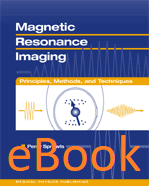
Magnetic Resonance Imaging: Principles, Methods, and Techniques, eBook
Author: Perry SprawlsISBN: 9781951134044
Published: 2000 | 200 pp | eBook
Price: $ 45.00
The British Journal of Radiology | May 2001
P>"This book is split into 15 chapters, each one being fairly brief and covering a small amount of theory. This makes the book extremely readable and quite easy to pick up when information about a particular topic is required. The author seems to be trying to take a fresh approach to explaining basic MRI concepts, which may be advantageous to people without a physics background. One criticism I would make is that some MR terminology is mentioned at the very beginning of the book (such as T1 and T2), but is not really explained until subsequent chapters. There are also some points made that are slightly inaccurate, or have not been explained clearly enough, such as the explanation of the alignment of nuclei in a static magnetic field (Chapter 3).
"The general imaging process is explained fairly briefly but adequately. There is some repetition between chapters covering the imaging process and spin echo imaging methods. The section on gradient echo imaging does cover some more advanced topics. Although the explanations are good they are, however, somewhat lacking in detail.
"It is only in Chapter 9 that concepts such as frequency and phase encoding are introduced. It could be said that to introduce these ideas at this later stage is a good idea as it has given the reader a chance to get to grips with the practicalities of MRI. However, the more inquisitive reader may have wondered before this point how the image is actually produced from the data that are acquired.
"The two chapters on Image Detail and Noise and Acquisition Times and Procedure Optimisation are excellent, and complement each other well.
"The next chapter deals with Vascular Imaging, which starts off explaining the basics, such as the difference between black blood and bright blood imaging, very well. However, the rest of the chapter does not follow a particularly logical order. The physical bases of the various angiography techniques are split up from the explanations of the actual techniques themselves, which I found rather confusing.
"The chapter on Functional Imaging was much better and gave a very good overview of diffusion processes within biological systems as well as clear and concise descriptions of BOLD and perfusion imaging
"Some of the explanations in the chapter covering artefacts were a bit vague, such as the one regarding motion artefacts in the phase encoding direction. However, the theory behind wrap around artefacts was described in a clear, non-mathematical way. The final chapter of the book gave a good summary of MR safety.
"Generally, the book benefited from short chapters, with many good, clear diagrams. The inclusion of a mind map and summary at the end of each chapter helped to consolidate the information contained within each one, although the mind maps were occasionally slightly unclear. I have a few misgivings about the order in which the information has been presented, but the author seems to have given a lot of consideration to the consistency of how he has represented the facts throughout the book and has linked individual chapters well. There seemed to be some variation in the quality of the writing, but overall I think this is a good introductory text to MRI, and is accessible to readers without much of a background in physics."
A. Darekar
The British Journal of Radiology
May 2001


